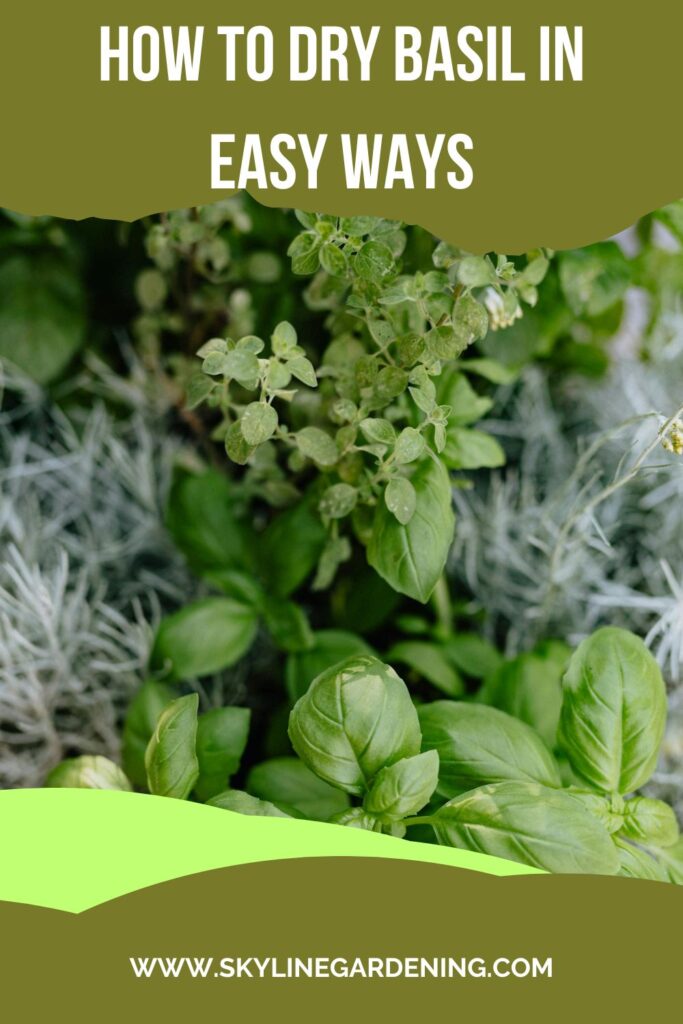Beautiful Plants For Your Interior

How to Dry Basil In Easy Ways
Basil is a beloved herb in many kitchens, known for its aromatic leaves and versatility in culinary dishes. Whether you have an abundant garden or just a few pots on your windowsill, learning how to dry basil can help you preserve its flavor and aroma long after the growing season. Let’s take a look at various methods of drying basil, ensuring you get the best results every time.
Why Dry Basil?
Drying basil is an excellent way to extend the life of your harvest. Fresh basil leaves are delicate and tend to wilt quickly. By drying them, you can retain their flavor and use them in cooking throughout the year. Dried basil is a fantastic addition to soups, sauces, and a variety of dishes, offering a concentrated taste that enhances your culinary creations.
Best Time to Harvest Basil for Drying
To get the most flavorful dried basil, harvest the leaves just before the plant flowers. This is when the essential oils are at their peak. Early morning, after the dew has dried but before the sun is too hot, is the ideal time to harvest.

How to Dry Basil: Methods
1. Air Drying Basil
Air drying is the most traditional method and requires no special equipment.
Step-by-Step Guide:
- Harvest the Basil: Cut healthy basil stems, each about 6 inches long.
- Prepare the Basil: Remove any damaged leaves and wash the stems gently. Pat them dry with a paper towel.
- Bundle the Stems: Gather 4-6 stems together and tie them with a string or a rubber band.
- Hang the Bundles: Hang the bundles upside down in a warm, dry, and well-ventilated area, out of direct sunlight. A dark place like a pantry or a closet works well.
- Wait: Allow the basil to dry for about 1-2 weeks. The leaves should be brittle to the touch when fully dried.
- Store the Dried Basil: Remove the leaves from the stems and crumble them into an airtight container. Store in a cool, dark place.
2. Oven Drying Basil
Oven drying is quicker than air drying but requires careful attention to avoid burning the leaves.
Step-by-Step Guide:
- Preheat the Oven: Set your oven to the lowest possible temperature (around 170°F or 75°C).
- Prepare the Basil: Wash the basil and pat it dry thoroughly. Remove the leaves from the stems.
- Arrange on a Baking Sheet: Place the leaves in a single layer on a baking sheet lined with parchment paper.
- Dry the Basil: Place the baking sheet in the oven. Leave the oven door slightly ajar to allow moisture to escape. Dry for about 1-2 hours, checking frequently.
- Cool and Store: Once the leaves are crisp and dry, remove them from the oven and let them cool. Store in an airtight container.
3. Microwave Drying Basil
Microwave drying is the fastest method but requires caution to prevent over-drying.
Step-by-Step Guide:
- Prepare the Basil: Wash and thoroughly dry the basil leaves.
- Arrange on a Plate: Place a single layer of basil leaves between two paper towels on a microwave-safe plate.
- Microwave: Microwave on high for 20 seconds. Check the leaves and repeat in 10-second intervals until the leaves are dry and brittle.
- Cool and Store: Allow the leaves to cool before storing them in an airtight container.
4. Using a Dehydrator
A dehydrator is an efficient tool for drying basil, especially if you have a large harvest.
Step-by-Step Guide:
- Prepare the Basil: Wash and dry the leaves thoroughly.
- Arrange on Trays: Place the leaves in a single layer on the dehydrator trays.
- Set the Dehydrator: Set the temperature to 95°F (35°C) and dry for 12-24 hours.
- Check for Dryness: The leaves should be brittle and crumble easily.
- Store: Cool the leaves and store them in an airtight container.
Tips for Storing Dried Basil
- Airtight Containers: Use airtight containers to prevent moisture from re-entering and spoiling the dried basil.
- Cool, Dark Place: Store in a cool, dark place to maintain the basil’s flavor and color.
- Label and Date: Always label and date your containers to keep track of freshness.
Benefits of Drying Basil
Drying basil not only extends its usability but also ensures you have a steady supply of this herb for your culinary needs. It’s an economical way to preserve your harvest and reduce food waste. Moreover, dried basil retains much of its nutritional value, providing vitamins and antioxidants even after drying.
People also ask
-
How do I know when basil is fully dried?
Dried basil leaves will be brittle and crumble easily. If they still feel soft or flexible, they need more drying time.
-
Can I dry basil in the sun?
Sun drying is not recommended for basil as it can cause the leaves to lose their flavor and color due to exposure to direct sunlight.
-
Can I use dried basil in place of fresh basil in recipes?
Yes, dried basil can be used in place of fresh basil. However, dried herbs are more concentrated, so use about one-third the amount of dried basil as you would fresh.
-
How long does dried basil last?
When stored properly in an airtight container in a cool, dark place, dried basil can last up to a year while retaining its flavor.
-
Is there a difference in flavor between air-dried and oven-dried basil?
Air drying preserves more of the basil’s natural oils, leading to a slightly more intense flavor compared to oven drying, which may reduce some of the essential oils due to heat exposure.
Final Thoughts on How to Dry Basil
Drying basil is a simple and effective way to preserve the essence of your urban garden. Whether you choose air drying, oven drying, microwave drying, or using a dehydrator, each method has its advantages. By following these steps, you can enjoy the fresh taste of basil all year round.
Now that you know how to dry basil, give it a try and savor the delightful flavors of this versatile herb in your cooking throughout the year.




